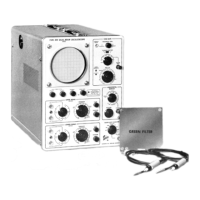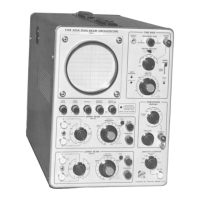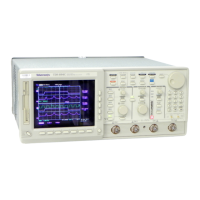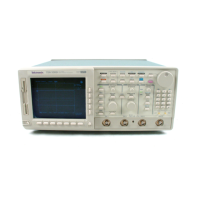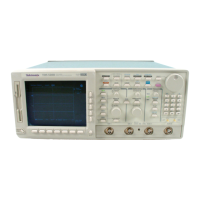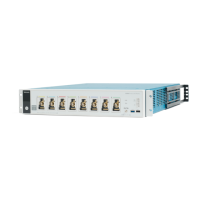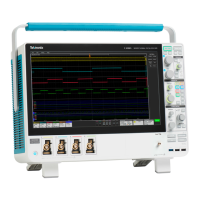Performance Check— Type 503
VARIABLE CALIBRATED (fully
clockwise)
POSITION Midrange
+ INPUT GND
-IN PUT GND
3. Turn the POWER AND SCALE ILLUM. control clock
wise and adjust the graticule illumination as desired.
4. Allow the Type 503 to warm up for at least 5 minutes
before proceeding further.
the INTENSITY control to avoid damage to the CRT phos
phor.
c. Change the HORIZONTAL SENSITIVITY switch to 1
mV/CM.
d. With the DC BAL control, adjust the spot to the same
position noted in the .2 VOLTS/CM switch position.
e. Change the SENSITIVITY switch to .2 VOLTS/CM.
f. Check— No horizontal shift of the spot as the SENSI
TIVITY switch is rotated from 1 mV/CM to .2 VOLTS/CM.
PERFORMANCE CHECK PROCEDURE
1. Check Focus and Astigmatism
a. Requirement— De-focused spot should be round or
slightly elliptical; focused spot should be sharp.
b. Rotate the INTENSITY control clockwise until the de-
focused spot appears in the graticule area.
c. Check—The spot should be round or slightly ellipti
cal. A distorted spot indicates a misadjusfed ASTIGMATISM
control.
4. Check CRT Horizontal Trace Alignment
a. Requirement—Trace parallel to the center horizontal
graticule line.
b. Change the HORIZONTAL DISPLAY switch to SWEEP
NORMAL (X I).
c. With the Vertical POSITION control, move the trace to
the center graticule line.
d. Check—Trace parallel to the center horizontal grati
cule line.
NOTE
On instruments having serial numbers lower than
000270, the ASTIGMATISM control is located on
the front panel and is easily adjusted during oper
ation of the oscilloscope.
d. Adjust the FOCUS control for a sharply-focused spot
while decreasing the INTENSITY to avoid damage to the
CRT phosphor.
e. Check—At optimum intensity, the spot should be sharp
and well focused.
2. Check Coarse DC Balance Adjustment—
Vertical
a. Requirement— No vertical shift of the trace as the
SENSITIVITY switch is rotated from 1 mV/CM to .2 VOLTS/
CM.
b. Change the SENSITIVITY switch to 1 mV/CM.
c. With the DC BAL. control, adjust the trace to the same
position in the .2 VOLTS/CM switch position.
d. Change the SENSITIVITY switch to .2 VOLTS/CM.
e. Check—No vertical shift of the trace as the SENSI
TIVITY switch is changed from 1 mV/CM to .2 VOLTS/CM.
3. Check Coarse DC Balance Adjustment—
Horizontal
5. Check .2 VOLTS/CM Gain— Vertical
a. Requirement— Vertical deflection accuracy ± 3 % .
b. Set the instrument controls as follows:
VERTICAL
SENSITIVITY
VARIABLE
+INPUT
-INP UT
POSITION
HORIZONTAL
SENSITIVITY
VARIABLE
+INPUT
-INP UT
POSITION
HORIZONTAL DISPLAY
LEVEL
.2 VOLTS/CM
CALIBRATED
GND
GND
Centered
.2 VOLTS/CM
CALIBRATED
GND
GND
Centered
SWEEP NORMAL (X I)
FREE RUN
c. Set the Standard Amplitude Calibrator for a 1-volt
square-wave output.
d. Connect the Standard Amplitude Calibrator output
through a BNC to UHF adapter, a 50-ohm cable and quick-
connect adapter (item 12 of Recommended Equipment) to
the Type 503 VERTICAL -(-INPUT connector, and change the
VERTICAL -(-INPUT switch to DC.
a. Requirement— No horizontal shift of the display (spot)
as the Horizontal SENSITIVITY switch is changed from 1 mV
to .2 VOLTS/CM.
b. Change the HORIZONTAL DISPLAY switch to the
HORIZ. AMPLIFIER (SWEEP DISABLED) position, adjusting
e. Adjust the SWEEP TIME/CM switch to a setting which
will present an easily-viewed display with a minimum of
flicker (.1 mSEC or 50 /xSEC).
f. Center the display in the graticule viewing area with
the VERTICAL POSITION control.
5-2
©
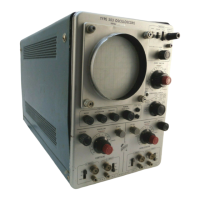
